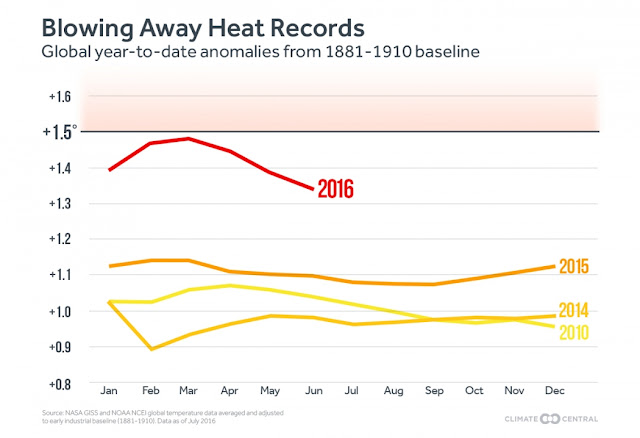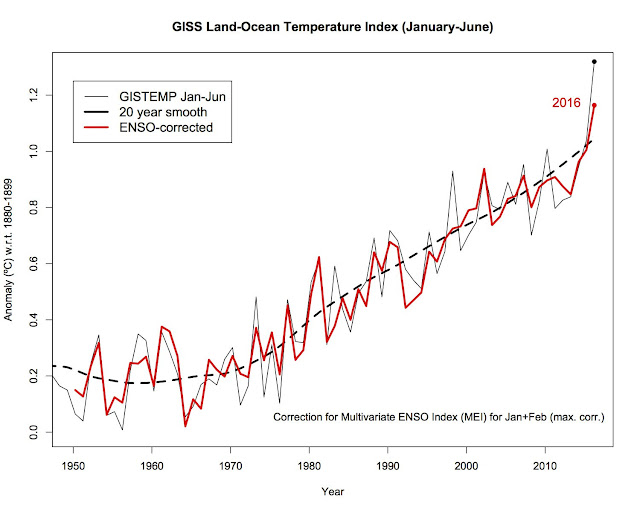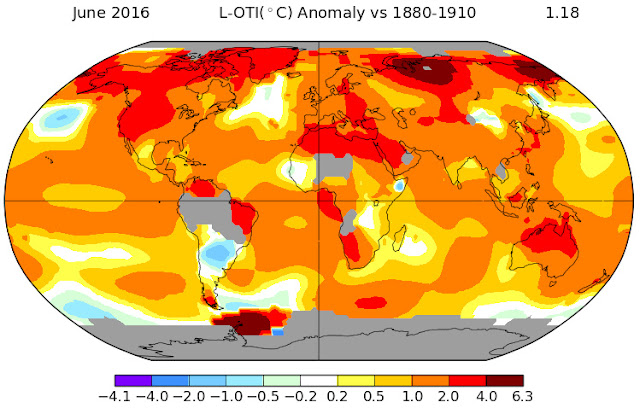Record temperatures in Kuwait and Iraq as heatwave spikes pose increasing health risk
The heat danger to human health was outlined by Steven Sherwood and Matthew Huber (2010) in the study: An adaptability limit to climate change due to heat stress which I reported on in May 2010: Scientists outline health limits of heat stress with Climate Change.
Here is how the Independent from the UK reported the event:
A weather station in Mitribah, a remote featureless area of north-west Kuwait, took the temperature last week during an intense heatwave that continues in parts of the Middle East. The mercury in neighbouring Iraq on the same day soared to 53.9C (129F) in the ancient city of Basra.
The World Meteorological Organisation (WMO) is investigating the report. If found valid and verified, they will almost certainly be the two highest temperatures ever recorded on the planet. The WMO media release explained:
Large parts of the Middle East and North Africa were gripped by heatwaves since last week. Temperatures exceeding by a large margin the seasonal averages, and over a sustained period. This affected, in particular, the northern part of countries in the Arabian Gulf and North Africa.Mitrabah reportedly saw a temperature of 54.0°C on 21 July and the city of Basra in Iraq recorded a temperature of 53.9°C (128°C) on Friday 22 July. Southern Morocco also saw temperatures of between 43°C and 47°C.
Governments issued heat-health warnings and took measure to minimise impacts on population. However the refugee population in the Middle East were the most affected, with heat exacerbating their fragile situation and suffering.
The low humidity during these scorching temperatures is a saving grace, allowing for evaporative cooling as long as people stay in shaded areas and keep well hydrated.
Friday, record heat in 12z Basrah Iraq = 129°F 54°C temperature and 1°C Dew Point = 4% relative humidity pic.twitter.com/RGgAmsxFqB
— Ryan Maue (@RyanMaue) July 22, 2016
Last year in Iran the city of Bandar Mahshahr clocked an air temperature of 46°C (115°F) and a dewpoint temperature of 32°C (90°F), creating a heat index of 165°F, according to Andrew Freedman in Mashable. Dewpoint temperature is an indication of the level of humidity. High humidity combined with high temperatures pose a significant health hazard as our human skin cannot cool by evaporation, resulting in greater danger of heat stress and heat strike.
We need to reduce greenhouse gas emissions to meet the "well below 2 degrees C" target of the Paris Climate Agreement, but we also need to incorporate climate adaptation and acclimatization strategies to minimise impact of extreme heat events on population health.
Rising temperatures pose a human health risk
A study published in 2015 in the International Journal of Environmental Research and Public Health highlighted the problems in human adaptation or acclimatization to extreme heat events we are now seeing in such places as the Middle-east and South Asia. Liz Hanna and Peter Tait in Limitations to Thermoregulation and Acclimatization Challenge Human Adaptation to Global Warming run through the human limitations of our thermo-regulatory system and assess the health risks and possibilities for climate adaptation.
The authors highlight the long term temperature and heat trend:
The rapid recent rise in heat extremes underscores our central claim that adaptation to protect human health, and indeed planned mitigation strategies, dangerously underestimate the real health threat of warming in the coming decades, and most critically, in the longer term future, when today’s children turn 50. Turning now to extreme heat events, heat records and prolonged heat waves have increased by more than a factor of ten in some continental regions, including parts of Europe, and the worldwide average is fivefold (Coumou et al 2013).
The paper goes into detail about the thermoregulation model for the human body, and on limits to physiological acclimatization to extreme heat events.
"The capacity to significantly upscale acclimatization diminishes among those in hot regions, where acclimatization is already approaching thermal maxima for human tolerance. Survival will require capacity to lessen extreme heat exposures through expansion of existing technical and behavioral adaptations, where possible. These hot nations are at extreme heat risk. That many megacities are situated in hot regions means that billions of people currently have restricted capacity to substantially boost their acclimatization capacity sufficiently to ensure their future health and well-being in a hotter climate. The high humidity endured by many of these megacities will further escalate the risk." Hanna and Tait argue.
Heat stress risk has substantially been addressed at an individual level, Hanna and Tail argue, with the population health threat glossed over briefly if at all. "Medical and nursing curricula have largely overlooked heat exposure as a population health threat, and instead focused on managing hyperthermia in individuals."
Part of the reason for this is that there is "considerable variation in heat tolerance ... between regionally dispersed human populations, and both between and within sub groups within each population." Although global patterning shows there is disproportionate vulnerability among certain population subgroups, including in particular "the aged, cardiac compromised and otherwise unwell, the obese and very young, and people with multiple health risks."
The authors found a lack of population health studies focusing on ambient temperature. "We found no population level studies on human tolerance of ambient temperatures. However there is a growing literature highlighting reduced worker performance in the heat. To date, our understanding of human heat generation and thermal tolerances is primarily derived from studies measuring the responses of athletes, university students, and military personnel, who are relatively fit and young. Hence caution must be applied when translating findings to the general population..."
While some population climatization is possible, and indeed already happens with seasonal change in temperatures, it will be limited to varying extents in the various population subgroups.
"Increasing population level acclimatization, and physical fitness, will assist heat tolerance, to a point. Climate projections suggest there will be temperature – humidity combinations which will make movement dangerous even for the fully acclimatized. Many parts of the world are already at or beyond, this threshold where sustained physical exercise outdoors is not possible without potentially fatal hyperthermia. If collective mitigation efforts fail to restrict warming to under 2 °C, as is becoming increasingly more likely, all people on Earth will become vulnerable to heat extremes. Even the highly acclimatized will be subject to thermal environments that can overwhelm their thermoregulatory system capacity, when heat gain and heat storage exceed cooling potential. Therefore, temperature induced limitations in capacity for humans to engage in normal daily physical activity, for domestic, commuting, recreational or professional purposes, will become progressively more common, in a warming world."
Most cities this century will experience a new climate range of temperatures. Climate departure is already happening, and indeed Oceans are already outside historical variability as cities and ecosystems follow.
It is clear that no matter whether we can limit global average temperatures to well below 2 degrees C as the Paris Agreement states, we will need to acclimatize and adapt to much higher temperatures and extreme heat events in a warmer world. Hanna and Tait make this abundantly clear as part of their study conclusion, which states in part:
"Acclimatization to a hotter world is a necessity for survival. However there are limitations. Adaptation to this new world can only partly be achieved through physiological responses. The remainder must derive from orchestrated strategies to reduce exposures via alterations to social, cultural technological and behavioral patterns. Shifts in housing and urban design, clothing, socially accepted behaviors and working hours will be required, as well as reorientations in industry, infrastructure and transport. Such major transformational changes will require decades to achieve, especially in the realm of infrastructure, housing and urban design. The complexity and embedded character of existing systems throughout the socio-political and economic fabric of society, coupled with propensity for inaction suggest that a coordinated multi-frontal approach is essential. This is necessary for human survival and sustained societal functioning in an increasingly hot climate.
Record temperature spike in First 6 months of 2016
The global average temperature data is in for the first six months of 2016. It is blowing away the records of past years. We have had 14 consecutive record setting months, with 2016 now likely to be the hottest year on record after the record setting 2015.
El Nino has now abated, but it only provided a very small proportion of these extreme temperature anomalies.
June was 0.90°C above the 20th century average according to NOAA and 0.79°C above the 1951-1980 average.
According to NOAA’s records, we have had an unprecedented 14 consecutive record-hot months.
Deke Arndt, the head of the climate monitoring division at NOAA’s National Centers for Environmental Information, said that the long-term warming trend is still clear, in an email to Climate Central.
"It's important to keep perspective here. Even if we aren't setting records, we are in a neighborhood beyond anything we had seen before early 2015," Arndt said. "We've left the 20th century far behind. This is a big deal."
Gavin Schmidt, head of NASA GISS said on twitter: "Record for last 6 mon partly due to El Niño (which has just finished), but would still have been a record w/o it."
If we compare June's temperature anomaly to the 1880-1910 base period, then the temperature anomaly was 1.18C according to NASA GISS data.
Sources:
- World Meteorological Organisation (WMO) media release 26 July 2016 - WMO examines reported record temperature of 54°C in Kuwait
- Climate Central, 19 July 2016: First Half of 2016 Blows Away Temp Records
- Hanna, E.G.; Tait, P.W., Limitations to Thermoregulation and Acclimatization Challenge Human Adaptation to Global Warming. Int. J. Environ. Res. Public Health 2015, 12, 8034-8074. doi:10.3390/ijerph120708034 (Full Paper)
Get Involved
If you'd like to help with maintaining or developing the website, contact us.
Publish
Publish your stories and upcoming events on Indybay.






